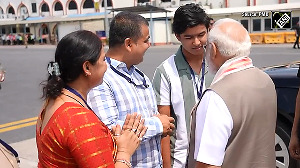 The biological weapons convention is a non-starter in spite of the efforts of many states in the world for the last five decades mainly because the US is not ready to accept the ‘verification protocol’ which could allow the formation of some official mechanism for inspections, says Ajay Lele.
The biological weapons convention is a non-starter in spite of the efforts of many states in the world for the last five decades mainly because the US is not ready to accept the ‘verification protocol’ which could allow the formation of some official mechanism for inspections, says Ajay Lele.
As per recorded history, an estimated 500 million people died of smallpox (the biggest-ever viral killer disease) in the 20th century. This disease is known to have troubled the human race for at least 3,000 years. During the last few decades, after a sustained effort of vaccination at the global level, it became possible to eradicate this disease completely from the earth and by 1980 the world had been declared free from smallpox.
Since then, from the point of view of future research and for production of vaccines in case of some unforeseen circumstances, samples of live virus are being stored at two locations as per World Health Organization guidelines. One site is the Centers for Disease Control and Prevention in Atlanta, the United States, and the second site is the State Research Center of Virology and Biotechnology (VECTOR) in Novosibirsk, Russia. The WHO oversees the inspection of both facilities and certifies their safety and security.
On July 1, 2014, it was reported that scientists have discovered several vials of smallpox left in a cardboard box in an unused storage room at the National Institutes of Health in Bethesda, Maryland, near Washington, DC. These samples apparently date back to the 1950s. It’s an irony that such deadly vials are found in the US, a country which preaches the rest of the world about bio-safety and bio-security.
Today, various questions could be raised regarding the safety record of the US bio labs. Last month US authorities had announced the temporary closure of the laboratories in Atlanta. This was necessitated because potentially infectious live anthrax bacteria samples were sent to laboratories unequipped to handle them. This was followed by the small-pox incident. Immediately after that, it was also discovered that a CDC lab had accidentally contaminated a relatively benign flu sample with a dangerous H5N1 bird flu strain. Luckily, in all these cases, no untoward incident happened and no humans were found infected, including the scientists working in these labs.
These incidents illustrate how poorly the infectious agents are being handled even in the US’s highest-security labs. It is difficult to guess how much damage to human life could have taken place if the stored bio agents had started affecting humans. Particularly, in case of small-pox spread, it would have been very difficult to arrest the infection in a short span of time because the medical symptoms of small-pox infection become ‘visible’ only one or two weeks after the individual has got infected. During this period, unknowingly, this individual starts transmitting the infection to others.
The vials of smallpox found recently in the US have been ‘secured’ and shifted to the CDC containment lab and are presently being tested to understand their lethality and other features. Subsequently, these vials would be destroyed.
It is surprising that a country like the US, where many governmental and private agencies are for years studying the various critical aspects of bio-safety, bio-security, and bio-containment, has to witness such carelessness regarding the management of harmful biological material. It is important to note that this issue is not only related to health aspects but also of extreme importance from the point of view of bioterrorism.
For many years there have been various international efforts involving agencies like the United Nations, WHO and others to highlight the biological challenges and improve awareness. There are specific guidelines available for laboratory bio-security and every country also formulates its own guidelines. There are international instruments available in the form of the Biological and Toxic Weapons convention (BTWC, 1975), WHO’s guidelines on health regulations, various UN formulated guidelines directly or indirectly dealing with the management of crops and livestock. Also, the United Nations Security Council Resolution 1540 assists to improve understanding in regards to bio-safety and bio-security.
Today, the biological weapons convention is a non-starter in spite of the efforts of many states in the world for the last five decades mainly because the US is not ready to accept the ‘verification protocol’ which could allow the formation of some official mechanism for inspections. The US is opposing this to safeguard the interests of its biotechnology and pharmaceutical industry. At a national level, typically, every institution that handles dangerous pathogens is expected to have a committee in charge of the institution's bio-safety. The recent disclosures in the US labs indicate that their national level committees have failed to ensure laboratory bio-security.
In 2010, nuclear radiation leakage was reported in the scrap market in Mayapuri, New Delhi. At that point in time India’s department of atomic energy had kept the International Atomic Energy Agency in the loop regarding the management of this disaster. For the last couple of years the supervision of issues concerning the destruction of chemical weapons in Libya and Syria are being effectively managed by the Organization of Prevention of Chemical Weapons. In 1979, there was a Sverdlovsk anthrax leak incident in which anthrax spores got accidentally released from a military facility in the erstwhile USSR. Finally, in 1992, a group of Western inspectors had visited the site for overall assessment.
Unfortunately, for the management of biological issues there is no global watchdog like the IAEA or OPCW. The recent incidents of mismanagement of dangerous biological material by the US could have led to potentially disturbing consequences for public health or the environment. It is but obvious that the US agencies have failed to ensure efficient security. This incident highlights that there is a possibility that some other labs in the world could also have unaccounted pathogens and there exists a possibility that they even could be misused.
The question is, is the world prepared to address such challenges?
Image: A man dressed in a bio-hazard protective gear poses while holding a mock syringe as a sales representative displays Imvamune, a smallpox vaccine developed by Bavarian Nordic to fight bioterrorism, during the Global Security Asia 2007 conference in Singapore, March 27, 2007. Photograph: Vivek Prakash/Reuters.
Ajey Lele is a research fellow with IDSA.









